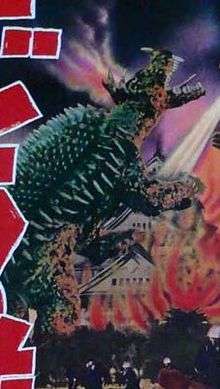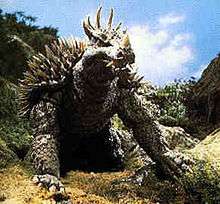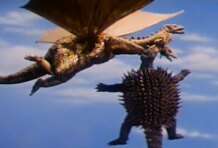Anguirus
Anguirus (Japanese: アンギラス, Hepburn: Angirasu) is a fictional monster, or kaiju, which first appeared in Godzilla Raids Again (1955), the second film in the Godzilla franchise. Anguirus is the first monster to be shown engaging in combat with Godzilla in a film.[1] Since then, the character has appeared conversely as an enemy and an ally of Godzilla in numerous films produced by Toho, including Destroy All Monsters, Godzilla vs. Gigan, Godzilla vs. Megalon, Godzilla vs. Mechagodzilla, and Godzilla: Final Wars. It has also appeared in other media, including comic books and video games.
| Anguirus | |
|---|---|
| Godzilla character | |
 Anguirus, as seen on the theatrical release poster for Godzilla Raids Again | |
| First appearance | Godzilla Raids Again (1955) |
| Last appearance | Godzilla: Planet of the Monsters (2017) |
| Created by | Motoyoshi Oda |
| Portrayed by |
|
| In-universe information | |
| Alias | Angilas |
| Species | Irradiated dinosaur |
Overview
Appearance
Anguirus is a quadrupedal giant or irradiated dinosaur that resembles an ankylosaurus.[2] Its head resembles a cross between that of a ceratosaurus and styracosaurus or sinoceratops. It has several horns on the top of its head and a single horn above its nose. Its face is long and drawn out, has rows of long, serrated teeth and has two tusks on his lower jaw. Its carapace is studded with long, sharp spikes. Anguirus' tail is covered with spikes (it also had a tail club in Godzilla: Final Wars). Its tail makes up most of its body length. Its hind limbs are longer than its forelimbs, and it can stand up on them to its full height, though it generally walks upon all fours. Anguirus has not one but five brains, one in its head which controls all of its organs, and one above each one of its limbs; each brain most likely controls the limb they are above. This gives Anguirus an advantage in battle, for it can react much quicker than most kaiju. Anguirus first appears in the Showa continuity as brown with yellowish spines, these colors are later changed in the Millennium series to light gray, with orange spikes and horns.
Powers and abilities

In its first appearance in Godzilla Raids Again, it is explained that Anguirus is capable of moving incredibly fast in spite of its bulk due to its brain extending into its chest and abdominal areas, allowing it to react more quickly. It is able to lunge at its opponents with massive leaps, as seen in Godzilla vs Mechagodzilla, and is also capable of burrowing substantial distances. Its long, burrowing journey started in Godzilla vs. Megalon and ended in Godzilla Vs Mechagodzilla, in which it resurfaces underneath Mechagodzilla and battles until its jaw is broken by the robot. Two of its attacks involve jumping backward to impale its opponents on its spiked carapace in Godzilla vs. Gigan and its vice-like bite; the most famous example of the latter being when it faced King Ghidorah in Destroy All Monsters and latched onto one of King Ghidorah's necks, its grip holding firm even after the space monster took flight. Anguirus also has the ability to heal and regenerate in a few minutes, as executives said it recovered almost immediately after Mechagodzilla broke its jaw. Anguirus has incredible durability, surviving being stomped on, being kicked with immense robotic force, being dropped from high altitudes, and surviving Godzilla's atomic breath.
In Godzilla: Final Wars, Anguirus was redesigned with the ability to curl itself into a ball and propel itself forward with tremendous speed. The Final Wars version also possessed a spiked tail club like a real ankylosaurus, though it was not used in combat. It also had leg spikes.
Behind the scenes
_Anguirus_head.jpg)
During the existence of the character, there have been three official Anguirus suits. The first and second were constructed under the supervision of Eiji Tsuburaya. After the release of Godzilla Raids Again, Toho was looking to release the movie to Western audiences but was having trouble finding a distributor. AB-PT pictures, an American distribution company, was producing their own movie The Volcano Monsters shortly after the release of Godzilla Raids Again. AB-PT attempted to incorporate the monster footage of Toho's film into their own, but had little success. They struck up a deal between the two companies; the second Godzilla suit and the original Anguirus suit were shipped to Los Angeles to film some additional scenes. Due to financial problems with AB-PT studios, the company collapsed and its assets were absorbed into other production companies. The second Godzilla suit and the original Anguirus suit both disappeared and remain lost to this day. The second suit, created for color filming, was built in 1968. The design had no radical changes from the original aside from some modification on the thickness of the spines and arrangement of the teeth. For Godzilla: Final Wars, a third suit was built incorporating modern sculpting methods and animatronics. The final suit is darker in color and somewhat more streamlined and biologically realistic in design.[3][4] Angurius' roars were created by using the sounds of a saxophone, a harmonica, an oboe, and a tuba.
Anguirus has been played by multiple actors throughout the Godzilla movie series:
- Godzilla Raids Again (first version) – Katsumi Tezuka
- Destroy All Monsters (second version) – Hiroshi Sekita
- Godzilla vs. Gigan (second version) – Yukietsu Omiya
- Godzilla vs. Megalon (second version) – Yukietsu Omiya
- Godzilla vs. Mechagodzilla (second version) – Momoru Kusumi
- Godzilla: Final Wars (third version) – Toshihiro Ogura
Film history
Shōwa period (1955–1974)
According to the English subtitles of the 1955 Japanese language film Godzilla Raids Again, Anguirus (spelled "Angilas" in that film) was properly called an Angilosaurus (which in Japanese is pronounced roughly the same as Ankylosaurus), a dinosaur described as "one of the stronger dinosaurs that lived in the prehistoric era." It is described in a textbook by Polish world animal specialist Plateli Hondon as "one of the few creatures that had a thorough hatred for war-like predators," which explains Anguirus' eagerness to fight Godzilla. The dinosaur Angilosaurus lived (according to the film) from 150-70 million years ago, and its remains were affected by the same hydrogen bombs that awoke Godzilla. In the English-dubbed version of Godzilla Raids Again (released as Gigantis the Fire Monster in the US), the name of the dinosaur is pronounced ""ANG-will-o-Saw-rus," and given the sub-moniker "Killer of the Living." They ruled the Earth at one time, according to the film, then disappeared suddenly. From an unnamed textbook in the movie (the same book that in the Japanese-language version was written by Hondon), a scientist reads that these creatures (the angilosaurs) may return from hibernation due to radioactive fallout. Anguirus is said to have "brains in several parts of its body, including the head, abdomen, and the chest."
Anguirus was the first enemy that Godzilla ever faced. Godzilla and Anguirus battled in Osaka, and after a fierce struggle Godzilla won with a bite to the neck and incinerated Anguirus' body by using its atomic breath.

Anguirus was reintroduced (presumably as a different creature than the one in Godzilla Raids Again) in a brand-new costume in the 1968 film Destroy All Monsters as an ally and best friend of Godzilla living with it on Monsterland, a man-made habitat for all of Earth's monsters in the Ogasawara Islands created at the end of the 20th century. This costume is reused throughout the remainder of the Showa series, and Anguirus continued in its capacity as Godzilla's ally and friend. It helped Godzilla repel the space monsters, Gigan and King Ghidorah, in 1972's Godzilla vs. Gigan. It and Godzilla then returned to Monster Island (presumably the same island featured in Son of Godzilla), which was later disturbed by nuclear bomb tests in 1973's Godzilla vs. Megalon. Rodan, perched on a mountain above, toppled down on top of Anguirus, who disappeared when it fell through the ground in a massive split in the ground.
Anguirus tunneled its way to a snowy region, where it witnessed Mechagodzilla's first emergence in Godzilla vs. Mechagodzilla. It followed Mechagodzilla underground to Japan where it revealed itself to call upon the real Godzilla and engage Mechagodzilla in battle. However, Mechagodzilla was too powerful for Anguirus and severely injured it, breaking its jaw in a bloody display. Anguirus was forced to retreat underground, although it managed to tip off humanity that its opponent was not the true Godzilla. Showa Anguirus was 60 meters (196 feet) tall and weighed 30,000 metric tons.
_Godzilla_vs_Anguirus.jpg)
Millennium period (2004)
Anguirus was intended to appear in the unmade film Godzilla X Varan, Baragon, and Anguirus: Giant Monsters All-Out Attack, set to be directed by Shusuke Kaneko and released in 2001. However, Toho requested that Kaneko replace Varan and Anguirus for the more popular King Ghidorah and Mothra, respectively, leading to the release of the film Godzilla, Mothra and King Ghidorah: Giant Monsters All-Out Attack.
After a 30-year absence, Anguirus made a return in the 2004 film, Godzilla: Final Wars as a controlled monster of the Xiliens. It appears in Shanghai, and tramples everything in its path, then engaged the flying UN battleship, Karyu. The Xiliens appeared suddenly and teleported Anguirus and the other monsters away. They told the humans that they eliminated the monsters to save Earth, but this was soon discovered to be a ruse; the Xiliens were controlling the monsters. In Shanghai, the Xiliens use their fighter ships to attack the Karyu. While the Karyu was distracted, Anguirus jumped and curled himself into a ball, crashing into the ship at its midpoint. Karyu went spinning in the air before colliding into the Oriental Pearl Tower.
Anguirus, King Caesar, and Rodan are pitted against Godzilla at Mt. Fuji. It successfully defeats all three monsters. King Caesar, Anguirus, and Rodan are then left in a heap at the base of the mountain. Godzilla did not kill its fallen foes as a nod to their status as allies of Godzilla during the Showa era. This is in contrast to the remaining majority of the monsters seen in the film, all of whom, aside from Zilla, were enemies of Godzilla during the Showa era, and were slain either by Godzilla, the Gotengo, or the mutants who were part of an anti-monster task force near the beginning of the film.
Millennium Anguirus was 90 meters (295 feet) tall, 160 meters (524 feet) long, and weighed 60,000 metric tons.
Reiwa period
Anguirus only appeared as a skeleton corpse in Godzilla: Planet of the Monsters and was killed along with Rodan by the chemical bio-weapon Operation Hedorah at the Great Wall of China. However, in the prequel novel, another Anguirus appeared in South Africa, then another one that was small appeared, a fourth individual battled Godzilla, along with Baragon and Varan, in Los Angeles, but Godzilla killed them. A corpse with a similar appearance to Anguirus was shown in the underwater city in Godzilla: King of the Monsters.
Appearances
Films
- Godzilla Raids Again (1955)
- Destroy All Monsters (1968)
- All Monsters Attack (1969, stock footage cameo)
- Godzilla vs. Gigan (1972)
- Godzilla vs. Megalon (1973)
- Godzilla vs. Mechagodzilla (1974)
- Godzilla: Final Wars (2004)
- Godzilla: Planet of the Monsters (2017, skeleton corpse)
Television
- Godzilla Island (1997–1998)
Video games
- Godzilla / Godzilla-Kun: Kaijuu Daikessen (Game Boy – 1990)
- Battle Soccer: Field no Hasha (SNES – 1992)
- Kaijū-ō Godzilla / King of the Monsters, Godzilla (Game Boy – 1993)
- Godzilla: Battle Legends (Turbo Duo – 1993)
- Godzilla: Monster War / Godzilla: Destroy All Monsters (Super Famicom – 1994)
- Godzilla Giant Monster March (Game Gear – 1995)
- Godzilla Trading Battle (PlayStation – 1998)
- Godzilla: Destroy All Monsters Melee (GCN, Xbox – 2002/2003)
- Godzilla: Domination! (GBA – 2002)
- Godzilla: Save the Earth (Xbox, PS2 – 2004)
- Godzilla: Unleashed (Wii, PS2 – 2007)
- Godzilla Unleashed: Double Smash (NDS – 2007)
- Godzilla (PS3, PS4 – 2014)
- Godzilla Defense Force (2019)
Literature
- Godzilla at World's End (novel – 1998)
- Godzilla vs. the Robot Monsters (novel – 1999)
- Godzilla: Kingdom of Monsters (comic – 2011–2012)
- Godzilla: Gangsters and Goliaths (comic – 2011)
- Godzilla: Legends (comic – 2011–2012)
- Godzilla: Ongoing (comic – 2012)
- Godzilla: The Half-Century War (comic – 2012–2013)
- Godzilla: Rulers of Earth (comic – 2013–2015)
- Godzilla: Cataclysm (comic – 2014)
- Godzilla in Hell (comic – 2015)
- Godzilla: Oblivion (comic – 2016)
- Godzilla: Monster Apocalypse (novel – 2017)
References
- Citations
- Bogue, Mike (2017). Apocalypse Then: American and Japanese Atomic Cinema, 1951-1967. McFarland & Co. pp. 175–176. ISBN 9781476668413.
- Lees & Cerasini 1998, p. 118.
- Archived January 7, 2009, at the Wayback Machine
- Ken Hulsey. "Monster Island News". Robojapan.blogspot.com. Retrieved 2015-09-27.
- Sources
- Lees, J.D.; Cerasini, Marc (1998). The Official Godzilla Compendium. Random House. ISBN 0-679-88822-5.CS1 maint: ref=harv (link)
External links
| Wikimedia Commons has media related to Anguirus. |